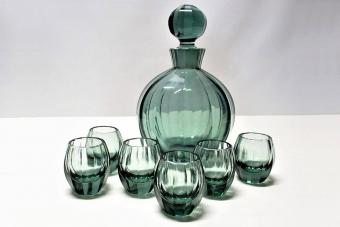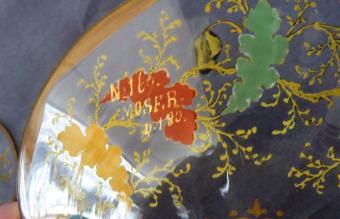
Moser glass is considered one of the most collectible types of glass ever molded; from gilt antique vases to delicately blown tumblers, the high quality and beautiful designs of these pieces make them a favorite of glass collectors around the world. While the company still produces luxury glassware for contemporary clients, there's stiff competition for owning one of their antique pieces. See how the Moser Glass Company came to garner such a renowned reputation and find out how it came to be featured in palaces and estates around the world.
History of the Moser Glass Company
The Moser Glass Company was founded by Ludwig Moser in 1857 in Czechoslovakia and was focused on creating high-quality, engraved glass products. In 1873, Moser received a medal at the Vienna International Exhibition, which led to an increased interest in his products. In 1893, Moser expanded his company to create a full-service glassworks business that employed over 400 people. By 1904, Moser was hired to create glassware for the Austrian Imperial Court. His continued affiliation with various royal courts inspired the company to create the slogan King of Glass, Glass of Kings. Unfortunately, the company's incredible success could not withstand German invasions during World War II, and many of the company's workers were sent to concentration camps. In retaliation, the remaining workers purposefully created flawed glass to install in tank windows and filter glasses that would shatter upon impact. Interestingly, the company was one of only 15 granted independence by communist forces in the post-war period, and the glass manufacturer actually remains an incredibly lucrative maker of glassware to this day.

Styles and Characteristics of Moser Glass
There are a variety of different styles of antique Moser glassware, all of which range in color and shape. Here are some of the characteristics of Moser glass that collectors identify today:
- Hoffman designs - Pieces made from one of the company's early designers, Johann Hoffman, are often found in opaque purple or black colors and feature depictions of animals and the female nude.
- Relief designs - Many of Moser's vases and drinkware pieces were created with various motifs carved into them using shallow relief techniques.
- Rich colors - Antique Moser glass was frequently made in rich colors like dark blue, purple and amber.
- Zwischengoldglas- This describes the process that Moser developed in the 1890s to press gold leaf between two layers of glass and heavily decorated flowers.

Identifying Moser Glass
Moser was one of the few Czechoslovakian glass companies to sign their products, making it a simple matter to identify their beautiful glassware. Unfortunately, not all Moser pieces are signed; however, there are other details you can look for as indicators that a piece of glassware originated from the Moser company, such as:
- Quality - Moser glass is renowned for its quality and the level of perfection within its pieces; finding imperfections such as bubbling or warping could indicate it's not an authentic Moser.
- Pontil - Check for pontil marks on the glassware; antique Moser glass was mouth blown and will have a pontil scar from where the glass blowers had the piece attached to a rod.
- Deep-seated decorations - Pieces that are decorated with gold-leaf will have their decorations deeply set into the glass; check for raised edges around the gold-leaf designs to see if they've been added close to the surface.

The Cost of Antique Moser Glass
Due to this glassware's incredibly high-quality construction, authentic artifacts of Moser glass can cost thousands of dollars. For example, one pink pillow vase from the early 20th century is listed for nearly $10,000 in one online auction. Similarly, a pair of 19th century Moser vases is listed for almost $50,000 in another auction. While it makes sense that these pieces which once adorned castles would have high values, it is a bit discouraging for casual collectors since most people can't afford to buy one of these exemplary pieces.
Caring for Your Moser Glass
Antique Moser glass is a beautiful example of Czechoslovakian workmanship, and if you happen to be lucky enough to have a piece in your collection, you should absolutely not wash it in a dishwasher or use it in a microwave. Moser glass should only be cleaned using a gentle soap; lay a dishtowel at the bottom of the sink before filling it with water to help prevent the Moser glass from chipping or breaking. Dry your piece with a soft cloth and keep the glassware away from direct sunlight. By taking good care of your glass, you will have an heirloom to pass down for generations.

Glassware Fit for a King or Queen
In terms of craftsmanship, there's truly nothing that compares to the Moser company's pieces. Their antique glassware is appropriately worth thousands of dollars and is held in the collections of esteemed estates around the world. Since most people don't have the opportunity to collect Moser glass on their own, see if there's any historic buildings or collections near you that have a Moser in their possession so that you too can take in the Moser company's legendary work.







